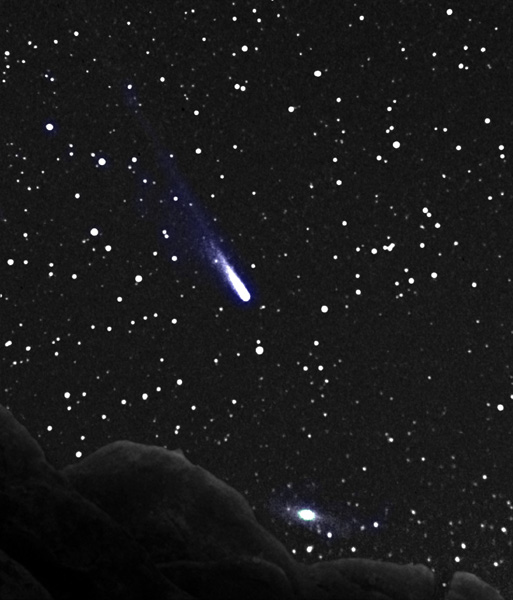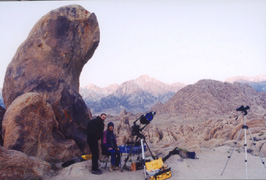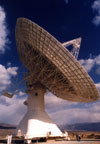Astro 28D: Field Astronomy
in the Eastern Sierra / Death Valley
April 5-7, 2002
 This
course took us to the high desert country of the Owens Valley. We camped at
a spectacular vista point underneath famed Gene Autry Rock in Movie
Flat in the Alabama
Hills in the foothills of the Sierra, between Lone Pine and Mount
Whitney. Here we had horizons of weathered granite rocks and hills, the scarp
of the Eastern Sierra, and beautiful views of the dark galaxy-filled skies of
Spring. Our grazing occultation expedition to the western "shores"
(the lake's dry, after all) of Owens Lake was frustrated by clouds, preventing
data-taking. However, our telescope viewing and photography of the conjunction
between Comet
Ikeya-Zhang and the Andromeda Galaxy went well, with Rick and Jay
teaming up to put together Cabrillo's ST7e and Nikon camera lenses, mounted
on our 8" Meade for guided digital astrophotography. During the day we
climbed Crystal Ridge, examined the sun and sunspots through the filtered 8"
Meade, toured the Owens
Valley Radio Observatory, visited Keogh Hot Springs
and photographed the ghost town of
Darwin in Death
Valley National Park.
This
course took us to the high desert country of the Owens Valley. We camped at
a spectacular vista point underneath famed Gene Autry Rock in Movie
Flat in the Alabama
Hills in the foothills of the Sierra, between Lone Pine and Mount
Whitney. Here we had horizons of weathered granite rocks and hills, the scarp
of the Eastern Sierra, and beautiful views of the dark galaxy-filled skies of
Spring. Our grazing occultation expedition to the western "shores"
(the lake's dry, after all) of Owens Lake was frustrated by clouds, preventing
data-taking. However, our telescope viewing and photography of the conjunction
between Comet
Ikeya-Zhang and the Andromeda Galaxy went well, with Rick and Jay
teaming up to put together Cabrillo's ST7e and Nikon camera lenses, mounted
on our 8" Meade for guided digital astrophotography. During the day we
climbed Crystal Ridge, examined the sun and sunspots through the filtered 8"
Meade, toured the Owens
Valley Radio Observatory, visited Keogh Hot Springs
and photographed the ghost town of
Darwin in Death
Valley National Park.
Check out the syllabus here
Post-Trip: Enjoy some scenes of our adventures below...
 Our
campsite was amidst the rocks of Movie Flat. Jay and Rick staked the high ground
for grand views of the Sierra, and mainly to enable photography of beautiful
Comet Ikeya-Zhang as it passed by the Andromeda Galaxy (above). We set our photo
equipment beneath famed Gene Autry Rock, familiar to film connoisseurs of the
classic westerns of the '50's. This view is facing west, towards Mount Whitney,
as the Sierra catch the first rays of the rising sun.
Our
campsite was amidst the rocks of Movie Flat. Jay and Rick staked the high ground
for grand views of the Sierra, and mainly to enable photography of beautiful
Comet Ikeya-Zhang as it passed by the Andromeda Galaxy (above). We set our photo
equipment beneath famed Gene Autry Rock, familiar to film connoisseurs of the
classic westerns of the '50's. This view is facing west, towards Mount Whitney,
as the Sierra catch the first rays of the rising sun.
We attempted pictures of the comet on Friday evening which were frustrated
by some lingering clouds. Saturday morning was clearer, and we bagged a nice
picture of the comet and galaxy rising over the huge granite boulder landscape
around us. I set up in the cold, at 4am, waiting in vain for Jay to wake up.
A well-tossed rock down to his tent finally got him moving. The effort was well
worth it. Jay and I got the excellent image of Comet Ikeya-Zhang and the Andromeda
Galaxy shwon at the top of the page. We used the ST-7XE CCD camera and Nikon
24mm lens, taking separate red, green, and blue images. Jay did the post processing,
tri-color stacking in MaxIm DL and importing the result to Photoshop along with
a second image of the exact same scene an hour later with the light of dawn
on the boulders of our Alabama Hills campsite. Adjusting the brightness of the
foreground produced an eerie image.
 Here
I am explaining the principles of collecting radio waves from distant astronomical
sources, at Owens Valley Radio Observatory. The array of dishes are independently
steerable.
Here
I am explaining the principles of collecting radio waves from distant astronomical
sources, at Owens Valley Radio Observatory. The array of dishes are independently
steerable.
 The
main instrument is the massive 40m dish. During our tour astronomers were studying
carbon monoxide emissions from the core of a distant galaxy in an attempt to
better understand the interstellar clouds which generate star and solar system
formation. Note our tiny ant-like selves next to the right corner of the base.
This observatory is owned by a consortium of universities, including UC and
Caltech, and was situated here because the Sierra and the White Mountains together
with the sparse population provide a radio-quiet environment.
The
main instrument is the massive 40m dish. During our tour astronomers were studying
carbon monoxide emissions from the core of a distant galaxy in an attempt to
better understand the interstellar clouds which generate star and solar system
formation. Note our tiny ant-like selves next to the right corner of the base.
This observatory is owned by a consortium of universities, including UC and
Caltech, and was situated here because the Sierra and the White Mountains together
with the sparse population provide a radio-quiet environment.
 A
rock band poster? Nope - my flock! Saturday morning we caravaned to Darwin,
an old gold mining town on the eastern rim of the Panamint Range of western
Death Valley National
A
rock band poster? Nope - my flock! Saturday morning we caravaned to Darwin,
an old gold mining town on the eastern rim of the Panamint Range of western
Death Valley National  Park.
There are still a few residents - retirees, artists, and general desert folk.
Most of the town however is a ghostly reminder of the area's mineral wealth
and mining heyday of the past, especially the old dance hall.
Park.
There are still a few residents - retirees, artists, and general desert folk.
Most of the town however is a ghostly reminder of the area's mineral wealth
and mining heyday of the past, especially the old dance hall.
Our leader, in Darwin - all camera'd up and ready for action.
 This
course took us to the high desert country of the Owens Valley. We camped at
a spectacular vista point underneath famed Gene Autry Rock in Movie
Flat in the Alabama
Hills in the foothills of the Sierra, between Lone Pine and Mount
Whitney. Here we had horizons of weathered granite rocks and hills, the scarp
of the Eastern Sierra, and beautiful views of the dark galaxy-filled skies of
Spring. Our grazing occultation expedition to the western "shores"
(the lake's dry, after all) of Owens Lake was frustrated by clouds, preventing
data-taking. However, our telescope viewing and photography of the conjunction
between Comet
Ikeya-Zhang and the Andromeda Galaxy went well, with Rick and Jay
teaming up to put together Cabrillo's ST7e and Nikon camera lenses, mounted
on our 8" Meade for guided digital astrophotography. During the day we
climbed Crystal Ridge, examined the sun and sunspots through the filtered 8"
Meade, toured the Owens
Valley Radio Observatory, visited Keogh Hot Springs
and photographed the ghost town of
Darwin in Death
Valley National Park.
This
course took us to the high desert country of the Owens Valley. We camped at
a spectacular vista point underneath famed Gene Autry Rock in Movie
Flat in the Alabama
Hills in the foothills of the Sierra, between Lone Pine and Mount
Whitney. Here we had horizons of weathered granite rocks and hills, the scarp
of the Eastern Sierra, and beautiful views of the dark galaxy-filled skies of
Spring. Our grazing occultation expedition to the western "shores"
(the lake's dry, after all) of Owens Lake was frustrated by clouds, preventing
data-taking. However, our telescope viewing and photography of the conjunction
between Comet
Ikeya-Zhang and the Andromeda Galaxy went well, with Rick and Jay
teaming up to put together Cabrillo's ST7e and Nikon camera lenses, mounted
on our 8" Meade for guided digital astrophotography. During the day we
climbed Crystal Ridge, examined the sun and sunspots through the filtered 8"
Meade, toured the Owens
Valley Radio Observatory, visited Keogh Hot Springs
and photographed the ghost town of
Darwin in Death
Valley National Park. 



